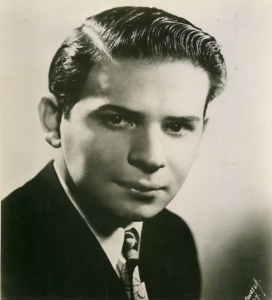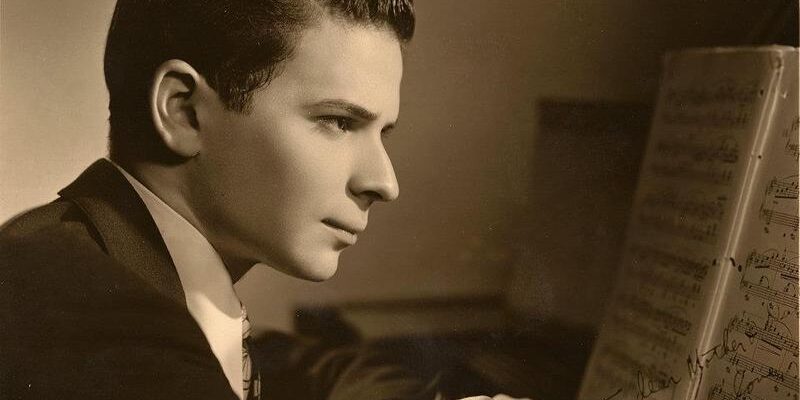 American pianist Byron Janis is celebrating his 95th birthday. An influential artist bridging the first half of the 20th century through the second half, Mr. Janis has had a long and distinguished international career as a soloist and recording artist.
American pianist Byron Janis is celebrating his 95th birthday. An influential artist bridging the first half of the 20th century through the second half, Mr. Janis has had a long and distinguished international career as a soloist and recording artist.
Born March 24, 1928, Janis studied from the age of 4 with Abraham Litow (who had trained at the Moscow Conservatory) before becoming a pupil of both Josef and Rosinna Lhévinne in New York. After a year of tutelage from the legendary Russian couple, their concert schedule restricted their teaching schedule – and at least one argument broke out between the couple about how he should be taught – so Janis then trained with Adele Marcus for the next several years.
He made a number of impressive appearances at a young age: a debut recital in Pittsburgh at age 9, an appearance on the Magic Key radio program the following year, and on September 12, 1943 at the age of 15 he made his orchestral debut playing Rachmaninoff’s Piano Concerto No.2 with the NBC Symphony Orchestra under Frank Black (not Toscanini as has sometimes been reported). That performance has only just been uploaded to YouTube (in surprisingly good sound!) and so I am delighted to be able to share it here. The young artist demonstrates wonderful facility and intelligence in a performance that is emotional without being sentimental, with exquisite phrasing, attentive voicing (note the left hand in the 2nd movement), and beautiful tone.
His Pittsburgh performance of the same work the following year (with the 13-year-old Lorin Maazel conducting) was attended by Vladimir Horowitz, who invited him to play for him before accepting him as his first pupil (only four ever trained with him).
With a weekly lesson for three years with the legendary pianist, Janis honed his craft and would then become the youngest classical artist signed to RCA at the age of 19. At his first session on November 24, 1947, he set down this noble reading of the Bach-Liszt Prelude & Fugue in A Minor BWV 543 (as well as three Chopin Etudes), and this grand interpretation captures in fine fidelity his beautiful tonal colours, marvellous pedal technique, and impeccable voicing.
In 1948 Janis toured South America and beginning in 1952 made his first European appearances, appearing with great conductors like van Beinum and Dorati, while setting down a number of solo and concerto recordings with RCA. This account of the Strauss/Schulz-Evler Arabesques on ‘An der schönen blauen Donau’ from an August 20, 1952 session captures heart of the pianistic tradition in which he was trained (Josef Lhévinne made the most legendary account of this work in 1928). Why this version features cuts when it was recorded in the LP era is unclear, and there is a different coda than I’ve ever heard, but the playing is marvellous, filled with old-school charm and elegance, with lovely tone, variety of articulation and skilled phrasing, idiomatic timing, and sensitive dynamic shadings.
Janis was the first American pianist to tour Russia during the Cold War, and while the initial response was anything but warm due to the intense political tensions, that quickly changed and he received rapturous ovations from tear-filled audiences. Mercury sent recording equipment to document the musical partnerships that resulted – an incredible cultural bridge at such a hostile time – and it was at this time that he recorded Rachmaninoff’s Piano Concerto No.1 with Kiril Kondrashin conducting the Moscow Philharmonic Orchestra. Janis emphasizes lyrical lushness over the nth degree of intensity (which can so often devolve into brashness in this work) with his beautifully polished sonority, fluid legato, terrific pedalling, natural timing, and lean, transparent textures.
The 1960s found Janis at the peak of his powers, and fortunately there is some important film footage of the pianist from this period. This filmed December 28, 1963 French television performance of Prokofiev’s Piano Concerto No.3 in C Major with Paul Paray leading the Orchestre National de la RTF captures his fusion of technical brilliance and insightful music-making. Avoiding the bombast and aggressiveness so often heard in readings of this work, Janis plays with clarity and deftness, with some more moderate tempi, while beautifully highlighting the piquant harmonic language and biting wit of the work.
This 1960s video clip of an abbreviated third movement of Rachmaninoff’s Piano Concerto No.3 is a fine example of the pianist’s playing in the repertoire for which he was widely celebrated, with dazzling finger-work complemented by wonderfully sensitive nuancing.
Back when classical music was still part of the wider landscape of cultural life, classical musicians would at times appear in mainstream entertainment programs. Here is a May 9, 1965 appearance by Janis on the legendary Ed Sullivan show in which he plays the Prokofiev Toccata that illustrates the strong influence of his tutelage with Horowitz. The pianist himself would come to say, “I knew exactly how he phrased, how he felt about a piece and it all got into my ear. At that time I did not realize what was happening. I was becoming a copy of Horowitz.”
Despite the profound influence of his teacher, Janis clearly had his own voice. This November 6, 1964 Salt Lake City recital, despite the sonic limitations due to it being an ‘unofficial’ recording, demonstrates the finest qualities of his pianism: beautiful tonal colours, intelligent phrasing, clarity of texture and articulation, and poised voicing.
HAYDN: Sonata in E-Flat Major Hob. XVI/49
SCHUMANN: Variations on a Theme by Clara Wieck
CHOPIN: Sonata No.3 in B Minor Op.58
RAVEL: Sonatine
PROKOFIEV: Visions fugitives, Op.22 Nos.5, 6, 8-11, 14-16, and Toccata Op.11
CHOPIN: Waltz in A Minor Op.34 No.2
FALLA: Miller’s Dance
Indeed, in addition to his own (and natural) tendency to emulate Horowitz in his early years, the pianist was (like many were and still are) typecast, which makes it fascinating to explore where his artistry lay outside these parameters. This January 30, 1960 Carnegie Hall concert reading of Mozart’s Piano Concerto No.23 in A Major K.488 with Leonard Bernstein conducting the New York Philharmonic Orchestra is a prime example. Decades before Horowitz himself would make his own recording of this work (only the fifth concerto he officially recorded), Janis delivered a marvellous performance. Decades afterwards, he had this reflection on the performance:
“How did I feel listening to the Mozart Concerto, all these forty years later? I’m pleased with it, I really am. And what I also like is that I was known as a big, virtuoso pianist; yes, for Chopin, but mostly through my recordings of Rachmaninoff, Tchaikovsky, Liszt. Well, now here’s Mozart and, for me, this is a Mozartian performance. People are funny — they love to identify you with something, and even if you do something else equally well, it’s hard for them to accept it. It’s exactly like typecasting in the movies, and I hope this recording helps to break that. Actually, I used to play a lot of Mozart and I’d like to record some more, so I’m delighted to have this performance out there.”
Chopin was the pianist’s true love and in 1967 he discovered the manuscripts of alternate versions of two of the composer’s waltzes while in France, and then a few years later discovered some more at Yale University. In this video he recounts the tale and illustrates some of the differences in the famous Grand valse brillante Op.18.
Sadly, the pianist’s career was curtailed due to his struggles with psoriatic arthritis. He limited his appearances while medicating and concealing his condition, eventually making it public at a 1985 White House concert, where Nancy Reagan announced that Janis would be a spokesperson for the Arthritis Foundation as its National Ambassador to the Arts. He recounts his struggles with the condition (as well as some other key moments of his career) in this June 2003 appearance on The Today Show.
To close this tribute to Maestro Janis, a gorgeous performance from his own YouTube channel of Chopin’s Waltz Op.69 No.1 and Nocturne in E major Op.62 No.2 that demonstrate his deep affinity for the composer’s works, with some truly elegant nuancing and gorgeous tonal colours.

One comment
I am sorry if English mistakes but I’m French but not really bilingual
A wonderful musician who tried to continue his career by getting injections before recitals but unfortunately without lasting success. It is terrible what he went through.
Little anecdote
He left a very bad memory one day in a restaurant on the Côte d’Azur in France After having dined there with friends when they had all drunk too much, they decided, for fun, to throw glasses, crockery , bottles and everything else within their reach in the restaurant doing a lot of damage. Sobered the next day, he wrote out a check for the amount of damage and the “case” was closed and forgotten.
Some people cannot stand alcohol and lose all control and sense of reality. It is sad